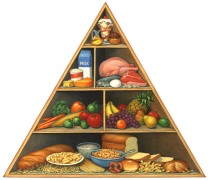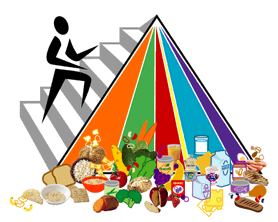 Generation II Food Pyramid
Generation II Food Pyramid
The U.S. Department of Agriculture's food pyramid once contained four food groups: fruits and vegetables, meat, grains, and dairy. The fruit and vegetable category made up the base of the pyramid, to show that they were the most important component of the diet. Unfortunately, this superior food pyramid from yesteryear is long gone. It was replaced with a grotesquely-bastardized version (pictured left) that contains five food groups; one of which is comprised of sugars and fats. Perhaps even worse is the fact that carbohydrates were made to be the base of the revisionist pyramid. It was supposed to be a guideline that explained how our foods should be proportioned, but it instead came to identify what we were already eating as a society.
Luise Light, Ed.D, a former U.S.D.A. nutritionist, wrote extensively about the food pyramid, long after she was asked to help revise it. Since leaving the U.S.D.A., she has written the book, A Fatally Flawed Food Guide, which chronicles her experience. It explains how the food pyramid was not redesigned in the interest of health, but on behalf of those in the processed foods industry.
"Where we, the USDA nutritionists, called for a base of 5-9 servings of fresh fruits and vegetables a day, it was replaced with a paltry 2-3 servings (changed to 5-7 servings a couple of years later because an anti-cancer campaign by another government agency, the National Cancer Institute, forced the USDA to adopt the higher standard). Our recommendation of 3-4 daily servings of whole-grain breads and cereals was changed to a whopping 6-11 servings forming the base of the Food Pyramid as a concession to the processed wheat and corn industries. Moreover, my nutritionist group had placed baked goods made with white flour -- including crackers, sweets and other low-nutrient foods laden with sugars and fats -- at the peak of the pyramid, recommending that they be eaten sparingly. To our alarm, in the 'revised' Food Guide, they were now made part of the Pyramid's base. And, in yet one more assault on dietary logic, changes were made to the wording of the dietary guidelines from 'eat less' to 'avoid too much', giving a nod to the processed-food industry interests by not limiting highly profitable 'fun foods' (junk foods by any other name) that might affect the bottom line of food companies.
"But even this neutralized wording of the revised Guidelines created a firestorm of angry responses from the food industry and their congressional allies who believed that the farmers' department (U.S.D.A.) should not be telling the public to eat less of anything.
"I vehemently protested that the changes, if followed, could lead to an epidemic of obesity and diabetes -- and couldn't be justified on either health or nutritional grounds. To my amazement, I was a lone voice on this issue, as my colleagues appeared to accept the 'policy level' decision. Over my objections, the Food Guide Pyramid was finalized, although it only saw the light of day 12 years later, in 1992. Yet it appears my warning has come to pass."
 Current Food Pyramid
Current Food Pyramid
The new food guide was influenced by the processed foods industry, as other health guides are usually written by the pharmaceutical industry. How convenient it all is. Perhaps this is why Jello (gelatin) is a staple of the diet inside American hospitals. For readers outside of the United States, we are completely serious.
In recent times, the pyramid was changed yet again, so that it no longer gives any clear recommendations whatsoever. It is fairly open to artistic interpretation. This is the goal. There is no legitimate health reason for having carbohydrates as the most important food group. That is, unless the agenda is to make people fat and diseased.
Related Articles
God's Nutrition: From The Big Guy Himself
Naturally Curing Infantile Phenylketonuria (PKU)
